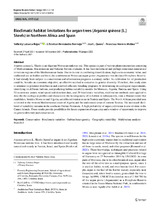Bioclimatic habitat limitations for argan trees (Argania spinosa (L.) Skeels) in Northern Africa and Spain
Autor
Labarca‑Rojas, Yalbeiry
Hernández Bermejo, Esteban
Quero, José L.
Herrera‑Molina, Francisca
Editor
SpringerFecha
2022Materia
ConservationBioclimatic variables
Habitat heterogeneity
Geographic suitability
Multivariate analysis
MaxENT
METS:
Mostrar el registro METSPREMIS:
Mostrar el registro PREMISMetadatos
Mostrar el registro completo del ítemResumen
Argania spinosa L. Skeels is an Algerian-Moroccan endemic tree. This species is part of various plant communities consisting of Mediterranean, Macaronesian and Saharan floristic elements. It has been introduced and perhaps sometimes naturalized in various regions of the Mediterranean basin. Due to its role in combating desertification, high socio-economic value, and traditional use as fodder and food, the southwestern Moroccan argan grove (Arganeraie) was declared Biosphere Reserve. It had already been subject to conservation and reforestation programs a century earlier. Its cultivation for oil production could be, besides an economic objective, an effective method to conserve its genetic diversity. Therefore, this study aims to estimate its potential distribution and establish efficient breeding programs by determining its ecological requirements, identifying its different habitats, and predicting habitat suitability models for Morocco, Algeria, Tunisia, and Spain. Using 53 occurrence points, wind speed and direction data, and 29 bioclimatic variables, multivariate methods were applied to describe the ecological profiles and characterize the heterogeneity of its habitat to subsequently, train a Maxent model that establishes, besides Morocco and Algeria, suitable cultivation areas in Tunisia and Spain. The North African potential area is limited to the western Mediterranean coast of Algeria and flat and coastal areas of eastern Tunisia. The increased likelihood of suitability remains in the southeast Iberian Peninsula. A high probability of argan cultivation is also evident in the Canary Islands. These results provide possibilities for future expansion of argan crop and a window of opportunity to improve its genetic diversity and conservation.

